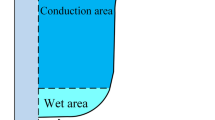Abstract
To investigate the response law and failure process of slopes in fully weathered granites under precipitation infiltration, a typical fully weathered granite slope is selected for sampling in South China. The physical simulation experimental study of rainfall-induced landslide is conducted, in which Weber criterion is used as the similarity criterion for precipitation. The research results reveal that under precipitation infiltration, the fully weathered granite slope responds quickly. Further, the water content increases sharply, and the matrix suction quickly dissipates. After dissipation, the matrix suction transforms into pore water pressure, which accelerates the deformation of the slope. The wet peak has a large infiltration depth in the slope, and the acceleration of the deep part is lower than that of the shallow part. Under the action of precipitation, the fully weathered granite model undergoes four stages of failure. Firstly, gullies and cracks appear; secondly, cracks propagate and link up; then, the soil on the slope surface swells and ruptures; and finally, the slope slides locally until the entire slope creeps, collapses, and transforms into a “soil flow”. It shows that the landslide will be triggered in fully weathered granite slope by precipitation when the precipitation intensity comes up to 155 mm/d, and the landslide occurs at an accumulated precipitation of 304 mm based on the analysis of precipitation similarity. Overall, the results can provide a reliable theoretical basis and abundant experimental data for the prevention, monitoring, and forecasting of geological disasters in granitic areas.











Similar content being viewed by others
References
Bai S, Wang J, Thiebes B et al (2014) Analysis of the relationship of landslide occurrence with rainfall: a case study of Wudu County China Arabian. J Geosci 7(4):1277–1285
Chen H, Lee CF (2003) A dynamic model for rainfall-induced landslides on natural slopes. Geomorphology 51(4):269–288
Dai FC, Lee CF (2001) Frequency–volume relation and prediction of rainfall-induced landslides. Eng Geol 59(3–4):253–266
Dietrich WE, Reiss R, Hsu ML et al (1995) A process-based model for colluvial soil depth and shallow landsliding using digital elevation data. Hydrol Process 9(3/4):383–400
Heller V (2011) Scale effects in physical hydraulic engineering models. J Hydraul Res 49(3):293–306
Huang R, Fan X (2013) The landslide story. Nat Geosci 6(5):325–326
Li Y, Meng H, Dong Y et al (2004) Main types and characteristics of geo-hazard in China-Based on the results of geo-hazard survey in 290 counties. Chinese J Geol Hazard Control 15(2):29–31 (in Chinese)
Li C, Ma T, Zhu X et al (2011) The power-law relationship between landslide occurrence and rainfall level. Geomorphology 130(3–4):221–229
Liu Y, Huang R, Huo J (2008) Study on stability evaluation and protection measures of weathered granite slope in a certain expressway. J Disaster Prev Mitig Eng 28(1):19–25 (in Chinese)
Liu G, Li C, Lu B et al (2020) Model test of shallow failure of fully strong weathered rock slope induced by rainfall. J Yangtze River Sci Res Instit 37(7):88–95 ((in Chinese))
Pradhan AMS, Kim YT (2014) Relative effect method of landslide susceptibility zonation in weathered granite soil: a case study in Deokjeok-ri Creek. South Korea Nat Hazards 72(2):1189–1217
Pradhan AMS, Kim YT (2015) Application and comparison of shallow landslide susceptibility models in weathered granite soil under extreme rainfall events. Environ Earth Sci 73(9):5761–5771
Segoni S, Piciullo L, Gariano SL (2018) A review of the recent literature on rainfall thresholds for landslide occurrence. Landslides 15(8):1483–1501
Zêzere JL, Vaz T, Pereira S et al (2015) Rainfall thresholds for landslide activity in Portugal: a state of the art. Environ Earth Sci 73(6):2917–2936
Zheng M, Jian W, Wu M (2005) Reliability analysis of stability of granite residual soil slope. Chin J Rock Mech Eng 24(2):5337–5340 (in Chinese)
Acknowledgements
This work was supported by the Hubei Provincial Natural Science Foundation (Grant No. 2016CFA023) and China Geological Survey Project Foundation (Grant No. DD20221734 &DD20160257 and DD20190304).
Author information
Authors and Affiliations
Corresponding author
Additional information
Publisher's Note
Springer Nature remains neutral with regard to jurisdictional claims in published maps and institutional affiliations.
Rights and permissions
About this article
Cite this article
Qi, X., Li, Q., Jiao, Y. et al. Experimental study on response law and failure process of slopes in fully weathered granites under precipitation infiltration. Environ Earth Sci 80, 685 (2021). https://doi.org/10.1007/s12665-021-09995-8
Received:
Accepted:
Published:
DOI: https://doi.org/10.1007/s12665-021-09995-8




